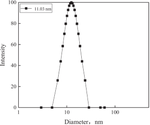Colloid and Polymer Science ( IF 2.4 ) Pub Date : 2024-04-14 , DOI: 10.1007/s00396-024-05253-y Mingjia Liu , Jijiang Ge , Guicai Zhang , Meijie Wang , Dengya Chen , Ping Jiang , Haihua Pei , Weixiong Chen , Jiasu Li

|
In order to solve the problem of poor stability of HPAM (partially hydrolyzed polyacrylamide) gel as a plugging agent at 150 °C, this paper investigates the preparation of a polymer gel strengthened with nano-SiO2, exhibiting good thermal stability, using a low-cost, low-hydrolysis anionic polymer. The experimental results indicated that when the gel was prepared with 1 wt% HPAM, 1 wt% water-soluble phenolic resin (WSPR) as a crosslinker, and 1 wt% nano-SiO2 as a stabilizer, the dehydration rate of the gel was less than 5 wt% after 180 days of aging at 150 °C. In order to identify the stability mechanism of nano-SiO2-strengthened polymer gel, we conducted rheological tests, Cryo-SEM analysis, Fourier transform infrared (FTIR) spectroscopy, and solid-state nuclear magnetic resonance (NMR) analysis on the polymer gel before and after adding nanoparticles. The methods described in the study demonstrate the excellent long-term thermal stability of the polymer gel strengthened with nano-SiO2 from both chemical bonding and microscopic perspectives. The results of rheological experiments indicated that the addition of nanoparticles improved the yield stress and long-term thermal stability of the gel. The scanning electron microscope (SEM) microstructure analysis confirmed that the addition of nanoparticles resulted in high-density cavities between the microscopic network structures of the gel. This facilitated the trapping of a significant amount of free water and the formation of a stable spatial mechanical support structure, ultimately enhancing the macro-mechanical strength of the gel. Additionally, FTIR and NMR experiments demonstrated that the nanoparticles effectively inhibited the hydrolysis of amide groups to carboxylate, thereby significantly preventing the high-temperature degradation of the gel and maintaining its strength after prolonged aging.
Graphical abstract
中文翻译:

纳米粒子增强聚合物凝胶的制备及其耐温机理
针对HPAM(部分水解聚丙烯酰胺)凝胶作为堵漏剂在150 ℃下稳定性差的问题,本文研究了纳米SiO 2增强聚合物凝胶的制备方法,该凝胶表现出良好的热稳定性,采用较低的热稳定性。 -成本低、水解度低的阴离子聚合物。实验结果表明,以1 wt% HPAM、1 wt%水溶性酚醛树脂(WSPR)为交联剂、1 wt%纳米SiO 2为稳定剂制备凝胶时,凝胶的脱水率为150°C 老化 180 天后,含量低于 5 wt%。为了明确纳米SiO 2增强聚合物凝胶的稳定性机理,我们对聚合物凝胶进行了流变测试、冷冻扫描电镜分析、傅里叶变换红外(FTIR)光谱和固态核磁共振(NMR)分析。添加纳米粒子之前和之后。研究中描述的方法从化学键合和微观角度证明了纳米SiO 2增强的聚合物凝胶具有优异的长期热稳定性。流变实验结果表明,纳米粒子的添加提高了凝胶的屈服应力和长期热稳定性。扫描电子显微镜(SEM)微观结构分析证实,纳米颗粒的添加导致凝胶微观网络结构之间产生高密度空腔。这有利于捕获大量的自由水并形成稳定的空间机械支撑结构,最终增强凝胶的宏观机械强度。此外,FTIR和NMR实验表明,纳米粒子有效抑制酰胺基团水解为羧酸盐,从而显着防止凝胶的高温降解并在长时间老化后保持其强度。



























 京公网安备 11010802027423号
京公网安备 11010802027423号